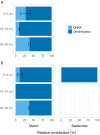Sediments From a Seasonally Euxinic Coastal Ecosystem Show High Nitrogen Cycling Potential
- PMID: 40600797
- PMCID: PMC12218870
- DOI: 10.1111/1462-2920.70139
Sediments From a Seasonally Euxinic Coastal Ecosystem Show High Nitrogen Cycling Potential
Abstract
Coastal ecosystems are susceptible to eutrophication and deoxygenation, which may alter their nitrogen cycle dynamics. Here, we investigated the microbial nitrogen cycling potential in the sediment of a seasonally euxinic coastal ecosystem (Lake Grevelingen, NL) in winter and summer. Activity tests revealed ammonium (NH4 +) oxidation potential with maximum potential rates up to 53 μmol g-1 day-1, even in anoxic sediment layers. A nitrifying microbial community was present in both oxic and anoxic sediment sections (up to 1.4% relative abundance). Nitrate (NO3 -), nitrite (NO2 -), and nitrous oxide (N2O) reduction potential were prominent across all sediment sections, with the highest potential rates (167 μmol NO3 -∙g-1 day-1) in the surface sediment in summer. Denitrification (79.3%-98.4%) and dissimilatory nitrate reduction to ammonium (DNRA; 1.6%-20.7%) were the major NO3 - removal pathways, as supported by the detection of the narG/napA, nirK/nirS, norB, nosZ and nrfA/otr genes in all sediment sections. The DNRA contribution increased with depth and with the addition of electron donors, such as monomethylamine. Anaerobic ammonium oxidation (anammox) was not detected in these eutrophic sediments. Combined, our results show that there is high potential for nitrogen removal in eutrophic coastal ecosystems, which may help further restoration measures.
Keywords: DNRA; coastal; denitrification; euxinic; nitrification; nitrogen cycle; sediment.
© 2025 The Author(s). Environmental Microbiology published by John Wiley & Sons Ltd.
Conflict of interest statement
The authors declare no conflicts of interest.
Figures






Similar articles
-
Impact of seasonal change on dissimilatory nitrate reduction to ammonium (DNRA) triggering the retention of nitrogen in lake.J Environ Manage. 2023 Sep 1;341:118050. doi: 10.1016/j.jenvman.2023.118050. Epub 2023 May 2. J Environ Manage. 2023. PMID: 37141713
-
[Factors influencing Nitrogen Removal in Different Plant Zones Along the Littoral Zone of a Typical Urban Lake in Nanjing].Huan Jing Ke Xue. 2025 Jul 8;46(7):4322-4334. doi: 10.13227/j.hjkx.202406191. Huan Jing Ke Xue. 2025. PMID: 40677051 Chinese.
-
A ubiquitous and diverse methanogenic community drives microbial methane cycling in eutrophic coastal sediments.FEMS Microbiol Ecol. 2025 Jul 14;101(8):fiaf075. doi: 10.1093/femsec/fiaf075. FEMS Microbiol Ecol. 2025. PMID: 40650567 Free PMC article.
-
Diversity and ecology of NrfA-dependent ammonifying microorganisms.Trends Microbiol. 2024 Jun;32(6):602-613. doi: 10.1016/j.tim.2024.02.007. Epub 2024 Mar 9. Trends Microbiol. 2024. PMID: 38462391 Review.
-
A critical review for removal of pre- and polyfluoroalkyl substances (PFAS) from landfill leachate: possible solutions with biological nitrogen removal and anammox systems.World J Microbiol Biotechnol. 2025 Aug 14;41(8):311. doi: 10.1007/s11274-025-04529-x. World J Microbiol Biotechnol. 2025. PMID: 40804600 Review.
References
-
- Æsøy, A. , Ødegaard H., and Bentzen G.. 1998. “The Effect of Sulphide and Organic Matter on the Nitrification Activity in a Biofilm Process.” Water Science and Technology 37, no. 1: 115–122.
-
- Bejarano Ortiz, D. I. , Thalasso F., Cuervo López F. D. M., and Texier A.. 2013. “Inhibitory Effect of Sulfide on the Nitrifying Respiratory Process.” Journal of Chemical Technology & Biotechnology 88, no. 7: 1344–1349. 10.1002/jctb.3982. - DOI
MeSH terms
Substances
Grants and funding
LinkOut - more resources
Full Text Sources
Miscellaneous

